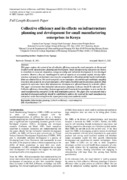| dc.contributor.author | Ng'ang'a, S.I | |
| dc.contributor.author | Onyango, G.M. | |
| dc.contributor.author | Kerre, B.W. | |
| dc.date.accessioned | 2015-10-09T13:06:54Z | |
| dc.date.available | 2015-10-09T13:06:54Z | |
| dc.date.issued | 2011-03 | |
| dc.identifier.uri | http://karuspace.karu.ac.ke/handle/20.500.12092/1859 | |
| dc.description.abstract | This paper explores the extent of use of collective efficiency among the wood enterprises in Kenya and its effect on the infrastructure planning and development. Small manufacturing enterprises are known to contribute to economic dynamism, entrepreneurship and industrial development in less developed countries. However, they are handicapped by lack of capacity to accumulate capital, develop infra- structure and acquire technologies necessary for competing in a liberalized global market individually. Data was obtained from 284 wood enterprises owner/managers selected through multistage sampling in western Kenya and by use of questionnaires, observation checklists and documentary analysis. Data analysis by regression shows that infrastructure development is affected linearly by collective efforts. The paper recommends that industrial infrastructure planning in Kenya should be informed by the Collective efficiency, Networking, Systems approach and Constructivism paradigms so as to anchor the small manufacturing enterprises in the industrialization process. The paper also recommends that a Jua Kali development authority should be established to address the needs of the small manufacturing enterprises sector borrowing from the export processing zones authority model. | en_US |
| dc.language.iso | en | en_US |
| dc.publisher | International Journal of Business and Public Management | en_US |
| dc.subject | Infrastructure planning, Collective efficiency, wood enterprises | en_US |
| dc.title | Collective efficiency and its effects on infrastructure planning and development for small manufacturing enterprises in Kenya | en_US |
| dc.type | Article | en_US |
